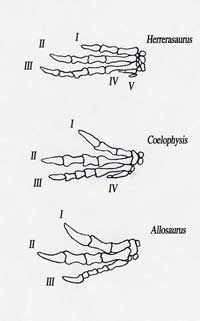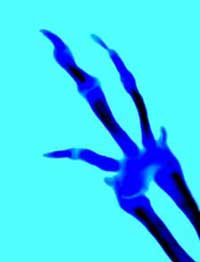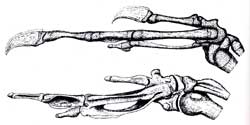






Steve Hunter, ncsce.org
What about birds? Up until a few years ago, there was no direct evidence as to which three fingers are present on a highly derived bird wing. Archaeopteryx is the earliest beastie that everybody seems to agree is a bird. Archaeopteryx has three fingers on its hands. There is no evidence trail in the fossil record suggesting bird digit identities. Unless, of course, birds are descended from three-fingered dinosaurs.
As long as there was no direct evidence to the contrary, it didn't seem out of line for cladograms to reflect bird hands as having the same digits (I, II, III) as maniraptoran hands.
However.
However.
In 2002, Larsson and Wagner presented the results of their research that sought to pin this down. They used molecular markers to further identify digit IV in the developing bird hand. This work confirmed the results of the alignment found by Burke and Feduccia.
Hand of hoatzin embryo, above, and adult, below, from Heilmann (1927) reproduced in Feduccia (1996).
These folks have pointed out that the genetic and chemical signals that cause the digits to form are distinct from the genetic and chemical signals that cause each digit to develop in a particular way. Smith proposes that sometime after the stage represented by Herrerasaurus, theropods lost digit I. The mechanisms that cause the digits to form the way they do shifted over one place so that digits II, III, IV and V end up looking like digits I, II, III and IV. In this scenario, we actually see in Coelophysis digits II, III and IV remaining prominent while digit V is going away. Maniraptors and birds have digits II, III and IV and all of the synapomorphies in the data matrices of the cladograms are preserved!
Fascinating idea.
But until such time as someone comes up with some way to test this idea, it is purely Ad Hoc.
As it stands now, the best independent evidence is that maniraptors and birds have different digits on their hands. But the data matrices of cladograms do not reflect that, because the results of previous cladistic analyses support birds being maniraptors. So the data going into the analysis is modified according to the results of the analysis. That is circular reasoning and bad science.
Cladists' claims of objectivity ring hollow.
Birds have digits II, III and IV on their hands. At this point, this is undeniable. So do we see the designation of bird digits changing to reflect this new research? And do we see cladograms showing bird and maniraptors with all sorts of characters in the wrist and hand which distinguish rather than unite the two groups?
(all are PDF files)
Feduccia and Nowicki, Naturwissenschaften (2002) 89:391-393
Galis, Kundrat and Sinervo, Trends in Ecology and Evolution, Vol. 18 No. 1 Jan. 2003
Feduccia, Trends in Ecology and Evolution, Vol. 18 No. 1 Jan. 2003
Larsson and Wagner, Trends in Ecology and Evolution, Vol. 18 No. 1 Jan. 2003
